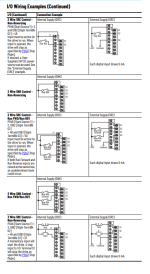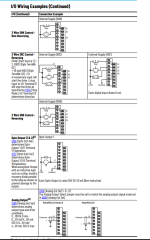Tfackler2000
Member
I am looking for some help with a project that I am working on to finish my maintenance apprenticeship. Any help would be greatly appreciated. My instructor and I will be very thankful.
I am trying to connect a PLC to a Powerflex 525 VFD. This is just a small conveyor based project in the classroom. The current instructor is new and is struggling with the same issues I am having. I want to use the outputs from the PLC to control the start and stop of the drive. I am not sure if this would be considered a 2 wire setup or a 3 wire setup. The way i have this connected right now is output 1 to terminal 1 (Stop) and output 2 to terminal 2 (start/run/fwd) and output 3 to terminal 3 (start/run/rev). The VFD is set as SRC. I can change the parameters using CCW and am very familiar with doing this. As of this moment when I turn power on to the system some of my outputs are flashing on/off. I am not sure if this is from the VFD, like some kind of feedback, or if there is another issue somewhere else. I will try to answer any questions concerning my project to the best of my knowledge.
The PLC is a 1769-L23E-QB1B
The VFD is a PowerFlex 525
Again any and all help is greatly appreciated.
Thank you
I am trying to connect a PLC to a Powerflex 525 VFD. This is just a small conveyor based project in the classroom. The current instructor is new and is struggling with the same issues I am having. I want to use the outputs from the PLC to control the start and stop of the drive. I am not sure if this would be considered a 2 wire setup or a 3 wire setup. The way i have this connected right now is output 1 to terminal 1 (Stop) and output 2 to terminal 2 (start/run/fwd) and output 3 to terminal 3 (start/run/rev). The VFD is set as SRC. I can change the parameters using CCW and am very familiar with doing this. As of this moment when I turn power on to the system some of my outputs are flashing on/off. I am not sure if this is from the VFD, like some kind of feedback, or if there is another issue somewhere else. I will try to answer any questions concerning my project to the best of my knowledge.
The PLC is a 1769-L23E-QB1B
The VFD is a PowerFlex 525
Again any and all help is greatly appreciated.
Thank you





